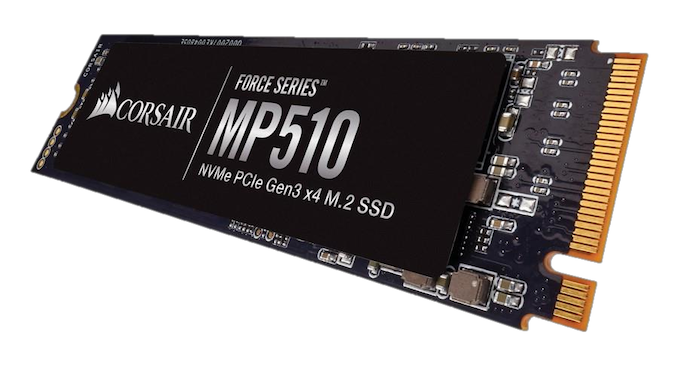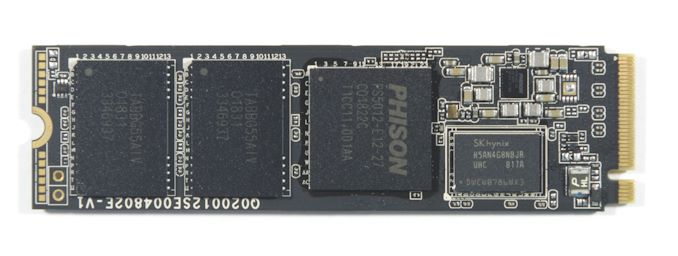The Corsair Force MP510 SSD (960GB) Review: A High-End Contender
by Billy Tallis on October 18, 2018 10:00 AM EST
The Corsair Force Series MP510 may appear at first glance to be an incremental update to the earlier MP500, but under the sticker it's an entirely new and far better drive. The MP500 was Corsair's take on the Phison E7 first-generation NVMe SSD controller paired with planar MLC NAND. The MP510 adopts the new Phison E12 controller and Toshiba's 64-layer 3D TLC NAND. The result is a drive that aims for the high end and actually makes it this time.
Earlier this year, we previewed the Phison E12 controller and its M.2 SSD reference design. The Corsair Force MP510 is based on that same hardware platform and features the same firmware version number, so not much should have changed except for the application of a Corsair logo and price tag. The Phison E12 is the high-end controller from their second generation of NVMe controllers, with the E8 as the entry-level NVMe controller with fewer PCIe lanes and NAND channels. Phison has close ties to Toshiba, and most Phison drives use Toshiba's NAND flash. Toshiba's transition to 3D NAND was relatively late and that stuck many Phison SSD vendors with uncompetitive SSDs last year, including most drives with the E7 controller. Toshiba's 64-layer 3D TLC has reversed that situation and is giving Phison SSD vendors access to cutting-edge flash that is fast, cheap, and power efficient. Phison's E12 controller allows drives to make the most of that flash.
| Corsair Force Series MP510 Specifications | ||||||
| Capacity | 240 GB | 480 GB | 960 GB | 1920 GB | ||
| Form Factor | double-sided M.2 2280, PCIe 3 x4 | |||||
| Controller | Phison PS5012-E12 | |||||
| NAND Flash | Toshiba BiCS3 256Gb 64-layer 3D TLC | |||||
| Sequential Read | 3100 MB/s | 3480 MB/s | 3480 MB/s | 3480 MB/s | ||
| Sequential Write | 1050 MB/s | 2000 MB/s | 3000 MB/s | 2700 MB/s | ||
| Random Read | 180k IOPS | 360k IOPS | 610k IOPS | 485k IOPS | ||
| Random Write | 240k IOPS | 440k IOPS | 570k IOPS | 530k IOPS | ||
| Rated Power |
Read | 6.1 W | 6.7 W | 6.9 W | 7.1 W | |
| Write | 3.5 W | 4.8 W | 5.6 W | 6.2 W | ||
| Idle | 30 mW | |||||
| Warranty | 5 years | |||||
| Write Endurance | 400 TB 0.9 DWPD |
800 TB 0.9 DWPD |
1700 TB 1.0 DWPD |
3120 TB 0.9 DWPD |
||
| MSRP | $65.99 (27¢/GB) |
$124.99 (26¢/GB) |
$235.99 (25¢/GB) |
|||
The Corsair Force MP510 is available in capacities from 240GB to 960GB, with a 1920GB model on the way. That largest model has slightly reduced performance specifications from the 960GB that we have tested, and the smallest 240GB model has significantly constrained performance, with only the sequential read speeds still in high-end NVMe territory.
All capacities have a rated write endurance of around 0.9-1.0 drive writes per day and a five year warranty period, which are standard for high-end consumer SSDs. Maximum power draw ranges from 6.1-7.1W depending on capacity, so the drive will get warm but thermal throttling shouldn't be a problem outside of synthetic benchmarks.
The Corsair Force MP510 faces very direct competition from other Phison E12 SSDs such as the MyDigitalSSD BPX Pro, which the MP510 is surprisingly undercutting on price at the moment. Other competitors include:
- the Samsung 970 EVO and Western Digital WD Black, flagship TLC SSDs from major brands that are only a little bit more expensive than the MP510
- The HP EX920, ADATA SX8200 and other similar drives based on the Silicon Motion SM2262 controller, some of which are currently cheaper than the MP510
Also included in this review are several entry-level NVMe drives, our results from testing an engineering sample of the upcoming Silicon Motion SM2262EN controller, and the Toshiba XG6 OEM SSD that will hopefully get a retail version soon.
| AnandTech 2018 Consumer SSD Testbed | |
| CPU | Intel Xeon E3 1240 v5 |
| Motherboard | ASRock Fatal1ty E3V5 Performance Gaming/OC |
| Chipset | Intel C232 |
| Memory | 4x 8GB G.SKILL Ripjaws DDR4-2400 CL15 |
| Graphics | AMD Radeon HD 5450, 1920x1200@60Hz |
| Software | Windows 10 x64, version 1709 |
| Linux kernel version 4.14, fio version 3.6 | |
| Spectre/Meltdown microcode and OS patches current as of May 2018 | |
- Thanks to Intel for the Xeon E3 1240 v5 CPU
- Thanks to ASRock for the E3V5 Performance Gaming/OC
- Thanks to G.SKILL for the Ripjaws DDR4-2400 RAM
- Thanks to Corsair for the RM750 power supply, Carbide 200R case, and Hydro H60 CPU cooler
- Thanks to Quarch for the XLC Programmable Power Module and accessories
- Thanks to StarTech for providing a RK2236BKF 22U rack cabinet.











42 Comments
View All Comments
ATC9001 - Friday, October 19, 2018 - link
Not bad...competition is good to drive prices down, but if I were in the market for an nvme drive I'd take the HP EX920 1TB for 199!euler007 - Friday, October 19, 2018 - link
I'm really liking these prices. If RAM comes down in price a new PC is in my future.enzotiger - Friday, October 19, 2018 - link
Please check your numbers. Random read IOPS of 610K is not only by far the highest IOPS among M.2, it actually beats Optane 905P. Highly suspicious.Billy Tallis - Monday, October 22, 2018 - link
The 610k IOPS for random reads is the advertised specifications from Corsair, not my own measurements. I don't test consumer drives at queue depths high enough to determine whether it can actually hit 610k IOPS, because that doesn't come close to representing any real consumer workload.Hxx - Friday, October 19, 2018 - link
those prices are wrong right? I see the 480 gb model for 240+ at amazon unless amazon is price gouging.eek2121 - Saturday, October 20, 2018 - link
All the big retailers have algorithms to automatically shift pricing based on supply vs demand. Anandtech lists the MSRPs, but if everyone rushes out to buy the drive at once, Amazon, Newegg, etc. want to make as much money as possible while still balancing supply vs demand, so the price automatically shifts up. I'm surprised people haven't figured this out yet. That's why you wait for demand to drop before buying a product.ballsystemlord - Sunday, October 21, 2018 - link
Tallis, where are the 4k sequential read and write tests? I have a use case for them!Billy Tallis - Monday, October 22, 2018 - link
I doubt it. Whatever OS and filesystem you are using is likely to have a prefetch mechanism that make your small block sequential reads into mostly large block reads, and write caching that will batch up small block sequential writes. If you're trying to bypass the write cache for small block writes, then you probably need to be shopping for an enterprise SSD.ballsystemlord - Monday, October 22, 2018 - link
Ok. Thanks!Violet Giraffe - Tuesday, November 13, 2018 - link
I'm keen to think a lot of real-life use cases are bound on small block reading speed. E. g. databases.